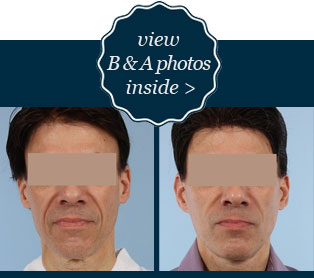
HARMONIC® FACELIFT (rhytidectomy)
It seems as if it sneaks up on you. You first begin to notice changes in your skin, perhaps a few brown spots if you haven’t been as diligent as you should have been with sunscreen in your younger years (tans seem to look so nice and healthy…) and/or a few lines and wrinkles from repeated facial expressions. Then you might start to notice some loss of facial fullness or volume, along with skin folds and creases around the mouth and eyes. Then, before you know it, you find yourself standing in front of the mirror, looking a little older than you feel, sometimes wondering what the difference might be if you pulled your facial skin just a little upward and backward (how much nicer that looks…then you let it back down…). Finally, you face the reality – you just don’t look like you did in your youth, full of life and energy and looking that way. Now you look a little more tired and feel a bit deflated, despite how you may feel. But it doesn’t have to be that way. A facelift, or rhytidectomy, is a surgical procedure that can help reduce the appearance of facial wrinkles and other signs of aging, including sagging in the middle of your face, loss of tone in your lower face (creating jowls), and perhaps a “double chin” even if you are not overweight. While it cannot turn back the hands of time, a facelift can help to provide a more youthful contour to the face and neck, giving you a refreshed and rejuvenated appearance.
What Is a Facelift?
When some think of a facelift, they imagine an unnatural, pulled-too-tight/seems-to-be-caught-in-a-windtunnel appearance to the face, usually a result of older and less sophisticated techniques which removed and tightened only the skin on the face. Newer techniques, such as those used by Dr. Moya however, include lifting and tightening your underlying facial tissues in addition to removing excess pockets of fat and skin, resulting in far more aesthetically-pleasing and natural-looking facial contours. Using this approach also means that less tension is put on the skin, helping prolong the results of the facelift. Depending on the extent to which the neck may be contributing to the appearance of aging, you may wish to also undergo a neck lift (either as part of a standard facelift or performed on its own) in order to optimize your results.
Who is a good candidate for a Facelift?
A facelift may be a good option for you if you have begun to notice:
- deepening of lines or wrinkles on your face (including “smile lines” around the mouth and eyes)
- loss of facial volume
- loss of a well-defined jawline (jowls)
- lines or “cords” in your neck
Ideal candidates are those who have good skin elasticity (so that facial skin can conform to your new and improved facial contours), realistic expectations, and good overall health. Because nicotine compromises blood flow to the tissues, which can cause healing issues, it is strongly preferred that patients do not smoke; smokers will need to make adjustments in their smoking habits both before and after surgery in order to optimize healing.
Facelift Options
One of the most important considerations is determining the type of facelift that is right for you, which is partially dependent upon the specific areas which are a concern for you as well as your expectations regarding your results. Dr. Moya will listen carefully to your concerns, and will perform a thorough evaluation so that he can provide you with the best possible outcome.
Dr. Moya offers several different types of facelifts. Depending on the extent of wrinkles, sagging, and loss of facial volume, as well as the degree of change you would like to see, your facelift choices include a standard facelift, limited facelift, or lower facelift (neck lift).
A standard (full) facelift will produce the most comprehensive results, since it targets a larger area. With this, Dr. Moya can address a number of your concerns, including sagging of your cheeks and lower jawline (jowls), lines around your mouth, and excess fat and skin under your chin and extending into your neck (along with neck “cords”). Of course, since it covers such a large area, the incisions are more extensive, beginning in the hairline at the temples, continuing around the ear, and ending in the lower scalp. A small incision is usually also made under the chin to address an aging neckline. During this type of facelift, the deeper tissues of the face and neck are lifted and repositioned, fat may be sculpted or redistributed, and the skin is then very carefully draped over the newly-defined and uplifted contours, with the excess trimmed away.
A limited facelift targets the middle to lower face, and is primarily designed to address sagging of your cheeks and lower jawline (jowls). As with the traditional facelift, the deeper structures as well as the more superficial skin and fat are addressed, but because the area is smaller, the incisions are shorter, and are placed only in front of and sometimes below and behind the ears.
A lower facelift (neck lift) targets the lower portion of the face and neck, and is designed to address sagging of the lower cheeks/jawline (jowls) as well as loose skin and “cords” or “bands” in the neck. Incisions for this procedure run in front of, below, and behind the ear, extending into the lower hairline behind the head, with an additional small incision underneath the chin. This procedure is best for those who are fairly pleased with the appearance of the upper portion of their face but are bothered by the lower portion and neck.
As with all surgical procedures, Dr. Moya will place your incisions in the most inconspicuous locations where they will be less visible. He will specifically use internal sutures with overlying skin glue for incisions that can more readily be seen, such as those in front of the ear and also underneath the chin. And because of his experience in utilizing innovative technologies including the HARMONIC® scalpel, you will not require postoperative drains making your recovery experience that much more comfortable.
Benefits of a HARMONIC® Facelift
Dr. Moya has had great success using HARMONIC® technology for many of his procedures, including facelifts. Whereas the more conventional and widely-used surgical instrument (Bovie) cuts and cauterizes (seals) tissues via electrical current, HARMONIC® devices use ultrasonic vibrations to perform the same tasks. This means that instead of using heat to cut and seal tissues (which can then spread and damage the surrounding tissues not being removed from the body), there is only minimal energy (heat) transfer and thus very little damage to surrounding tissues.
“So what does all of that mean for me?” you might ask. Well, for Dr. Moya’s facelift and neck lift patients, using a HARMONIC® scalpel means that there will be very little post-operative bruising, swelling, and pain, which then results in a much quicker return to your social activities. For certain patients, depending on the degree of surgery and/or length of surgical time needed, the advanced technology allows the procedure to be more easily performed under only local anesthesia with mild sedation, since there is no electrical stimulation of the nerves and muscles (unlike traditional instruments) which could cause muscle twitching and patient discomfort.
HARMONIC® technology is very different from traditional surgical instruments, and because of this, specialized training and modest amount of experience are necessary in order to obtain superior results. Dr. Moya has been utilizing this technology since 2007, and will be happy to show you what it can do for you.
Recovery After a Facelift
After your surgery, your incisions will be covered with bandages that must remain in place for 24 hours. In order to help swelling resolve sooner, you should sleep with your head elevated on pillows for the first several days and avoid excessive activity. Although you will have some swelling and bruising after your surgery, because of the use of the HARMONIC® scalpel, this will be significantly less than that which you would see with use of traditional surgical instruments, so that you will most likely be able to return to your normal social activities after one week. Overall recovery time, of course, will vary from patient to patient and will be somewhat dependent on the type of facelift performed, but you should expect to be fully recovered within 4 weeks, with return to exercise and more strenuous activities after 6 weeks.
Facelift Results
With Dr. Moya’s surgical approach you will see results almost immediately after your facelift, with final results achieved within 4 weeks. While a facelift will not prevent further facial aging, with proper care (including a healthy diet, hydration, sun protection, and skin care), you should be able to enjoy a more contoured and defined face for years.
“I had a decision to make: a “traditional” facelift or the HARMONIC® facelift with Dr. Moya. I did my research, as we all should! I made the right decision-I had next to no swelling or bruising. I did not even take any pain meds! I was back to work in one week (just looking amazingly refreshed and younger) – not showing any signs of a procedure. But, most importantly to me, I did not endure the concerns/issues of general anesthesia. All was done painlessly with local anesthesia. As a successful professional in the local area-time, convenience, quality of care, and appearance were of utmost importance to me. I look in the mirror, I’m thrilled – I made the right decision – I chose Dr. Moya and his expertise with the HARMONIC® facelift.”

